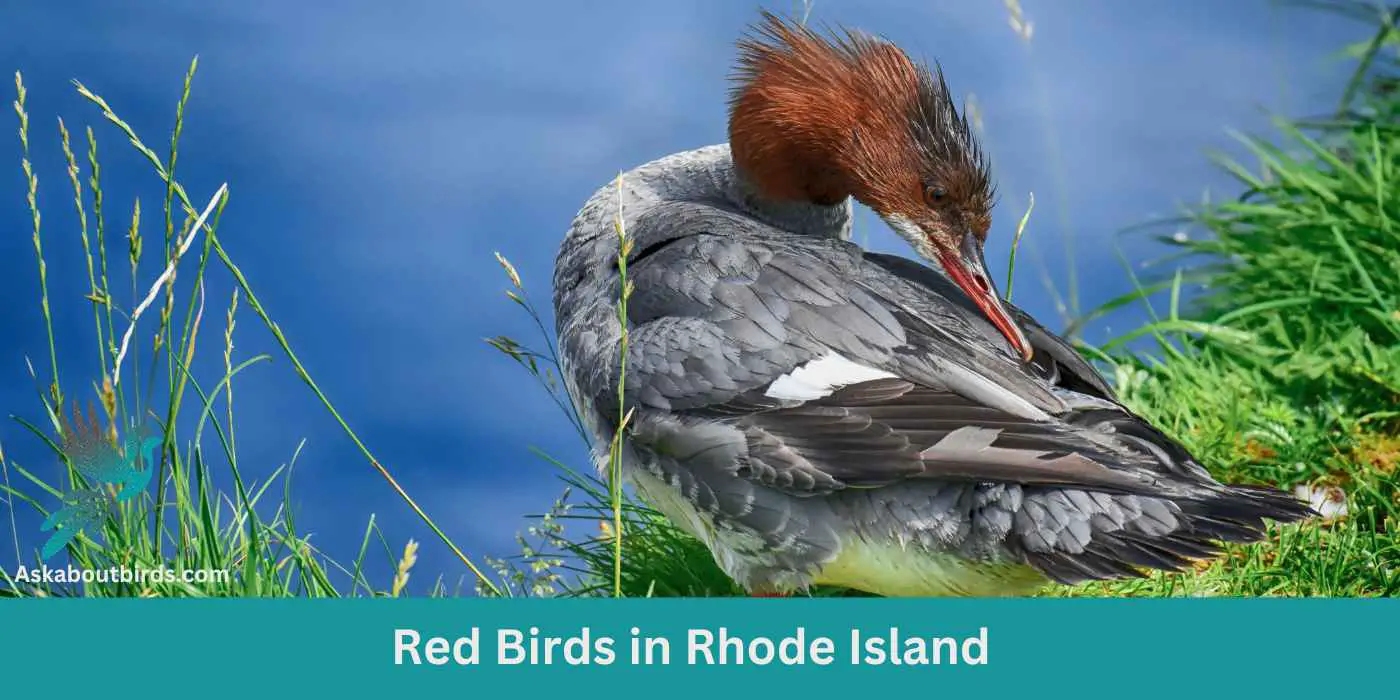Rhode Island, despite its compact size, is a treasure trove of avian wonders, especially for enthusiasts of red-feathered fliers. From coastal stretches to its verdant inland, this state hosts a colorful array of red birds that captivate the eyes and heart.
Dive into our detailed guide, showcasing the 10 most stunning red birds in Rhode Island, complete with a free photo guide to enhance your bird-watching experience.
Red Birds Found In Rhode Island
Rhode Island, the smallest state in the U.S., boasts a dynamic coastal landscape punctuated by bays, inlets, and estuaries. Despite its diminutive size, Rhode Island is a haven for diverse bird species, largely attributed to its varied habitats.
The state’s extensive coastline, coupled with its inland forests and freshwater wetlands, creates a mosaic of ecosystems that attract both migratory and resident birds.
The Atlantic Flyway, a major migratory route, passes directly over this region, bringing with it a plethora of birds during migration seasons.
Northern Cardinal


| Feature | Measurement |
|---|---|
| Scientific Name | Cardinalis cardinalis |
| Length | 8.3 – 9.1 in |
| Wingspan | 9.8 – 12.2 in |
| Weight | 1.19 – 2.29 oz |
The Northern Cardinal is an iconic North American bird, easily recognized by its vibrant color and melodious song.
Appearance: Male Northern Cardinals are a brilliant scarlet red, while females display a more subdued reddish olive. Both sexes have a distinctive black ‘mask’ on their face around the bill and a pointed crest on their head. The bird’s beak is robust, cone-shaped, and bright orange in color.
Diet: Northern Cardinals are primarily granivorous, with a diet largely consisting of seeds and grains. They also eat fruits and insects. These birds typically feed off the ground and are frequent visitors to bird feeders.
Reproduction: Northern Cardinals are monogamous, and a pair will breed together for life. The female typically builds a well-hidden nest in a dense thicket or shrub. She lays 2-5 eggs per clutch, which she incubates for around two weeks.
Red-Winged Blackbird
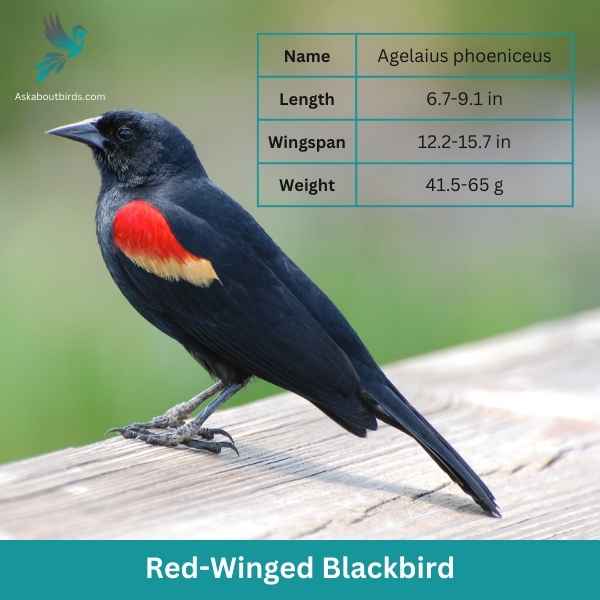
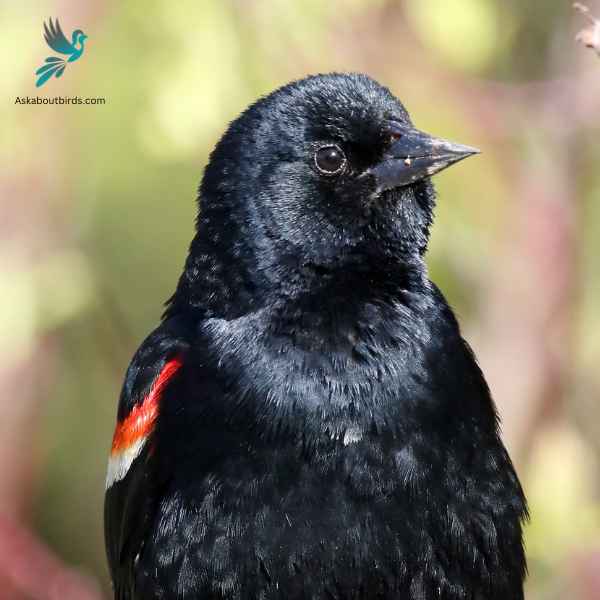
| Feature | Measurement |
|---|---|
| Scientific Name | Agelaius phoeniceus |
| Length | 6.7-9.1 in |
| Wingspan | 12.2-15.7 in |
| Weight | 41.5-65 g |
The Red-Winged Blackbird is a familiar sight across North America, especially in wetlands and open areas. Known for its striking coloration and distinct call, it is often seen perched on cattails or utility lines.
Appearance: Male Red-Winged Blackbirds are glossy black with bright red-and-yellow shoulder patches, while females are streaky brown, resembling a large sparrow. The males’ red patches become more prominent when they’re displaying or agitated.
Diet: Red-Winged Blackbirds primarily feed on seeds and insects. Their diet includes grains, sunflower seeds, and corn, but they also eat beetles, caterpillars, and other small invertebrates, especially in the breeding season.
Reproduction: Red-Winged Blackbirds nest in marshes, along watercourses, and in wet fields. The female constructs a cup-shaped nest using grass and sedge, attaching it to plants above water. She typically lays a clutch of 3 to 4 blue-green eggs, which she incubates for about 11-12 days. Males, being polygynous, often have multiple mates during a single breeding season.
Scarlet Tanager


| Feature | Measurement |
|---|---|
| Scientific Name | Piranga olivacea |
| Length | 6.3 to 7.5 in |
| Wingspan | 9.8 to 11.8 in |
| Weight | 23.5 to 38 g |
The Scarlet Tanager is a strikingly colorful bird known for its brilliant plumage and distinctive song.
Appearance: Male Scarlet Tanagers are notable for their vibrant scarlet bodies contrasted with black wings and tail, making them one of the most intensely colored birds. Females and juveniles, on the other hand, have a subdued olive-yellow body color with darker wings and tail.
Diet: The diet of the Scarlet Tanager is largely made up of insects, including beetles, cicadas, aphids, and others. They are adept flycatchers, seizing insects in mid-air or picking them off foliage. They also consume fruits and berries, especially during migration and in their winter habitats.
Reproduction: The female Scarlet Tanager builds a cup-shaped nest using twigs, rootlets, and grass, typically well-hidden in the dense foliage of trees. She lays 3 to 5 eggs and incubates them for about two weeks.
Summer Tanager


| Feature | Measurement |
|---|---|
| Scientific Name | Piranga rubra |
| Length | 6.7 in |
| Wingspan | 28 to 30 cm |
| Weight | 29 g |
The Summer Tanager is a medium-sized songbird admired for its radiant plumage and melodious song.
Appearance: Male Summer Tanagers are an impressive bright red, while females and juveniles present a softer, yellow-orange color. Both genders have a large, slightly hooked bill and relatively short tail.
Diet: Summer Tanagers primarily feed on insects, including bees and wasps, which they catch in flight or pick off vegetation. They are also known to eat fruits and berries, making them helpful in controlling pest populations and seed dispersal.
Reproduction: The female Summer Tanager builds a loose, shallow cup-shaped nest out of twigs and grass, usually hidden in the foliage of trees. The female typically lays 3-5 eggs, which she will incubate for about two weeks.
House Finch


| Feature | Measurement |
|---|---|
| Scientific Name | Haemorhous mexicanus |
| Length | 5–6 in |
| Wingspan | 8–10 in |
| Weight | 0.6–0.9 oz |
The House Finch is a small songbird widely distributed across North America and is commonly found in urban and suburban areas.
Appearance: Males of this species are brightly colored with crimson faces and throats, which can extend to the chest and back, while their flanks have streaks. The female is streaked brown and lacks the red coloring. Both have a square-tipped tail and a distinctively long, flat-topped bill.
Diet: House Finches primarily eat seeds, grains, and berries. They have a particular fondness for sunflower seeds and can be commonly seen at bird feeders. Occasionally, they will also consume insects, especially during the breeding season.
Reproduction: House Finches are cavity-nesters and might choose ledges, vents, ledges, and other urban settings. They might also utilize trees or shrubs. Their nests can be made of a wide array of materials, from feathers to twigs.
American Robins


| Feature | Measurement |
|---|---|
| Scientific Name | Leptotila plumbeicep |
| Length | 10.6-11.8 in |
| Wingspan | — |
| Weight | 160-200 g |
The American Robin is a widely recognized bird species known for its melodious song and early bird tendencies.
Appearance: American Robins are medium-sized birds with a distinctive appearance. Both males and females sport a gray to brown back and a warm red to orange breast and belly and gray wings. They also have a characteristic white eye-ring and a black head, but males are usually darker than females.
Diet: American Robins have a diverse diet that changes depending on the season. In summer, they feed heavily on earthworms, beetles, and other invertebrates, which they catch on the ground. During winter, they mostly eat fruits and berries.
Reproduction: American Robins usually build their nests in trees or shrubs, but they are also known to nest on human-made structures. The female lays a clutch of about 3 to 5 eggs, which she incubates for about 12 to 14 days.
Purple Finch


| Feature | Measurement |
|---|---|
| Scientific Name | Haemorhous purpureus |
| Length | 4.7–6.3 in |
| Wingspan | 4.7–6.3 in |
| Weight | 0.6–1.1 oz |
The Purple Finch is a vibrant songbird often mistaken for its close relative, the House Finch, but it exhibits a different hue and patterns.
Appearance: Males are raspberry red on the head, throat, and breast, with streaky brown backs and wings. The intensity of the red can vary among individuals. Females are brown and streaked all over but might show a slight blush on the face. They lack the strong facial patterns seen in female House Finches.
Diet: Purple Finches primarily consume seeds, with a preference for sunflower seeds, dandelion seeds, and buds. They also eat insects and berries, especially during the breeding season.
Reproduction: These finches often nest in conifers or mixed woodlands. The nest, typically located on a horizontal branch, is made from twigs and grass, then lined with feathers.
Red Crossbill

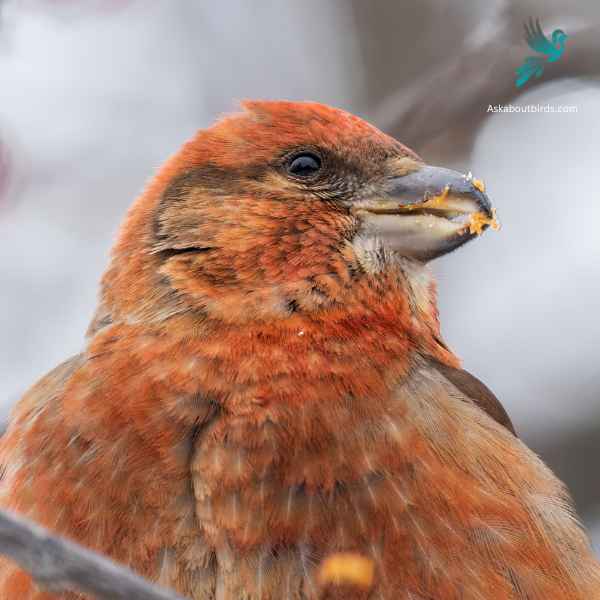
| Feature | Measurement |
|---|---|
| Scientific Name | Loxia curvirostra |
| Length | 5.5–7.5 in |
| Wingspan | 9.8–10.6 in |
| Weight | 0.9–1.4 oz |
The Red Crossbill is a distinctive finch known for its unusual bill, which has evolved to extract seeds from conifer cones.
Appearance: Males are typically bright red or orange, while females are greenish-yellow or olive. Both genders have the characteristic crossed bill, which they use to expertly extract seeds from tightly closed conifer cones.
Diet: Red Crossbills primarily feed on the seeds of coniferous trees, such as spruce, pine, and fir. Their specialized bills allow them to efficiently pry apart conifer cone scales to access the seeds.
Reproduction: Red Crossbills are somewhat nomadic and don’t adhere to a strict breeding schedule. Instead, they breed whenever and wherever food is abundant. Their nests are usually built on horizontal branches of conifer trees.
Red-bellied Woodpecker
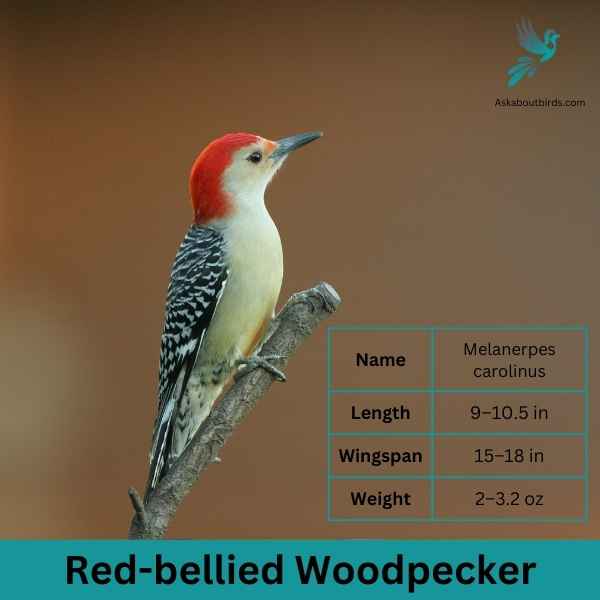
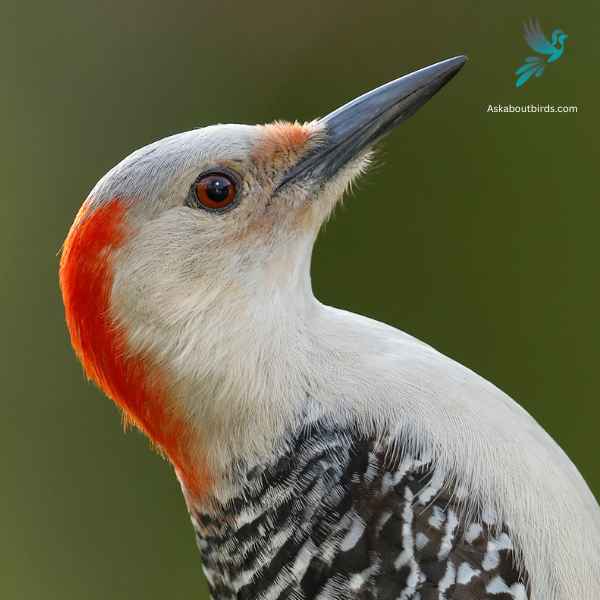
| Feature | Measurement |
|---|---|
| Scientific Name | Thryothorus ludovicianus |
| Length | 4.7–5.5 in |
| Wingspan | 11 in |
| Weight | 0.63–0.81 oz |
The Red-bellied Woodpecker is a medium-sized woodpecker commonly found in woodlands, forests, and backyards across the eastern and central U.S.
Appearance: The Red-bellied Woodpecker sports a pale gray face, throat, and belly, contrasted by a zebra-striped back. Its name derives from the subtle reddish tinge on its belly, but it’s more commonly recognized by the vivid red cap on the head of males and the partial red cap on females.
Diet: This woodpecker has a varied diet that includes insects, fruits, nuts, and seeds. They frequently forage on tree trunks and branches, using their sticky, barbed-tipped tongue to extract ants, beetles, and other insects from crevices.
Reproduction: Red-bellied Woodpeckers are cavity nesters, excavating holes in tree trunks for their nests. The inside of the nest is typically unlined or sparingly lined with wood chips.
Red-Breasted Merganser


| Feature | Measurement |
|---|---|
| Scientific Name | Mergus serrator |
| Length | 20–25 in |
| Wingspan | 26–29 in |
| Weight | 800–1,350 g |
The Red-breasted Merganser (Mergus serrator) is a species of sea duck known for its distinctive appearance and behavior. The bird boasts a slender, saw-toothed bill, a reddish-brown breast, and a fan-shaped, shaggy crest. In males, the head is strikingly green-black, the neck is white, and the back is black and white patterned. Females have a rusty brown head with a shaggy crest and a grayish body. Both sexes display the long, slender bill characteristic of mergansers, designed for catching and consuming fish.
Red-breasted Mergansers inhabit a wide range of environments, including freshwater lakes, rivers, coasts, and sometimes even open sea environments. The species is widely distributed across the Northern Hemisphere, breeding in the northern parts of North America and Eurasia, and wintering in milder climates. Their diet consists primarily of small fish, which they catch through rapid underwater dives. A unique behavior of Red-breasted Mergansers is their group hunting strategy, where they are often seen herding fish together to facilitate catching them. As of my knowledge cutoff in September 2021, the Red-breasted Merganser is listed as a species of “Least Concern” by the IUCN, indicating a stable global population. However, like all species, it could be impacted by future environmental changes and habitat loss.
Where to Spot Rhode Island’s Red Birds
In the compact yet ecologically diverse state of Rhode Island, several hotspots emerge as paradises for avid birdwatchers and red bird enthusiasts.
- Sachuest Point National Wildlife Refuge, Middletown: This coastal refuge is famous for its wintering population of Harlequin ducks, but it’s also a haven for various red bird species, especially during migration seasons.
- Trustom Pond National Wildlife Refuge, South Kingstown: As the state’s only undeveloped salt pond, Trustom Pond provides shelter to over 300 bird species year-round. The diverse habitats here are especially attractive to vibrant songbirds.
- Ninigret National Wildlife Refuge, Charlestown: With its unique combination of freshwater and salt ponds, this refuge is a magnet for a variety of birds, making it an excellent location to spot both resident and migratory red birds.
- Beavertail State Park, Jamestown: Offering stunning ocean vistas, this coastal gem is not only a must-visit for its scenic beauty but also for its abundant birdlife, particularly during migration periods.
- Block Island National Wildlife Refuge: Situated off Rhode Island’s southern coast, Block Island is a renowned birdwatching locale, particularly during fall migrations. The island’s diverse habitats cater to a multitude of red bird species.
| State’s Red Birds | Top Spots for Red Birds |
|---|---|
| Connecticut’s Red birds | 1. Hammonasset Beach State Park 2. White Memorial Conservation Center 3. Sherwood Island State Park |
| Massachusetts’ Red birds | 1. Plum Island – Parker River National Wildlife Refuge 2. Mount Auburn Cemetery 3. Cape Cod National Seashore |
FAQs on Red Bird Species Found in Rhode Island
Why are ruby throated hummingbirds frequently spotted near hummingbird feeders?
Ruby throated hummingbirds, iconic for their iridescent green plumage and dazzling red throats, are native to the eastern regions. These little birds live primarily in woodlands, gardens, and meadows. Due to their high metabolism, they have a strong affinity for sugar water, which is why many homeowners attract them with hummingbird feeders. While these hummingbirds are the stars of many gardens, other birds like the pine warbler and downy woodpeckers also frequent nearby trees, making bird watching a delightful experience.
How do common backyard birds, like the northern flicker, interact with bird feeders?
Birds like the northern flicker, easily identifiable by its long tail, dark line down its back, and characteristic white throat, are often year-round residents in various landscapes across the country, from wooded areas to city parks. These birds, along with other species such birds as the downy woodpecker and blue jay, often visit bird feeders stocked with black oil sunflower seeds. While birds such the northern flickers might primarily hunt insects on the ground or on tree trunks, the presence of black sunflower seeds at feeders can entice them to make regular visits, offering bird enthusiasts an up-close view of their behaviors.
Why are black sunflower seeds popular among common birds?
Black oil sunflower seeds are a favorite among many the most common birds here, especially those frequent backyard feeders. The seeds, rich in essential oils and nutrients, are especially attractive to birds such as the downy woodpecker, northern flicker, and tufted titmouse. Their thin shells make it easier for birds, even little ones, to crack open and access the nutritious kernel inside. Whether scattered on the ground or placed in feeders, these seeds are a magnet for various species, making them a staple for those wanting to attract a diverse array of birds to their gardens.
What characterizes the habitat preferred by the Rhode Island Red?
The Rhode Island Red, a distinct bird not just for its rich reddish hue but also for its dark gray plumage with white wing bars, thrives in areas with dense brush and shade trees. While not naturally a wild bird (it’s a breed of chicken), in an imagined scenario where it lives among other birds, it would likely prefer areas that provide shelter, safety, and ample feeding opportunities. Just like other common backyard birds, the Rhode Island Red birds would be enticed to visit feeders, a common treat many birds find hard to resist.

